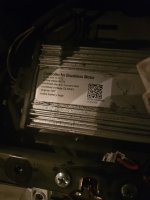My son's gio ebike smoked its charger. The bike continued to work properly. We bought a replacement charger of proper voltage and plugged it to charge, at which time the new charger went up in smoke. I checked for continuity between the charger input wires and found there was continuity. I eliminated the wiring to the controller with a multimeter and found continuity right at the controller. Am I safe to assume the controller has failed and shorted on the charging input side? The bike continues to work properly and I dont want to just guess and throw parts at it.
The controller doesn't have a "charging input", in that there isn't anything in a typical motor controller that has anything to do with charging. That is all handled at the charger, and inside the battery itself. Any short in the controller on battery wiring would prevent it from operating at all, and either start a fire in the wiring, or at least overheat it and damage it, if there is no fuse to blow and prevent that.
A blown fuse in the battery wires to the controller would also have prevented any operation of the scooter, and also any shorting of the charger...so that's also not a problem here.
Continuity on a controller from main B+ to main B- is likely to show continuity close to zero ohms at first connection to the meter (if the controller has been off for a while and the battery is not connected to the system at all), and rise in ohms until continuity doesn't show anymore after a while, as its' capacitors charge up.
If there is a DC-DC to run lights that is also on the main B+/B- of the system, paralleled to the controller, you're also charging it's caps and it will take even longer to reach non-continuity readings.
If the caps are already charged up to battery voltage, or the battery is still connected, then the meter is not going to have a valid reading (and could be damaged).
If the pack is lead-acid, there's no BMS to prevent or enable charging, and all the wiring in the charger port on the scooter would also go directly to the controller, so any short in the charger port wiring would be a short in all the battery wiring, and prevent operation of the scooter, unless there is a fuse between the batteries and the charger port. If there's no fuse there, or it isn't blown, then there's no short in the charger port wiring, etc.
Assuming the pack is lithium, it probably has a BMS.
Unless the BMS is a common-port type, the charging input wires are separate from all the discharge (controller-side) wiring (separate-port type BMS). Might have common positive, but negative would be separate, so wtihout the battery connected to the wiring, you'll get no continuity from the charging port wires to the rest of the system on the negative wire (and possibly on the positive). In this case, you could have a short on the charging port that doesnt' affect the rest of the system.
But...the BMS in the battery cannot protect against or stop outflow from the battery's charge port (only inflow from it), so a short in the charger port would drain the battery rapidly, and probably start a fire. (unless there is a fuse between the BMS charge port and the shorted portion of scooter charger port wiring).
The other possiblity is the BMS charge port FETs were destroyed by overheating when the charger port wiring shorted, so the cells are now disconnected permanently from the charging port, preventing a fire but leaving the battery unable to charge.
The short in the charge port wiring would still exist and potentially damage any charger plugged into the port, and be detectable as a short with an ohms test or continuity test (but do this only with the battery disconnected from everything, just in case).
If the battery only has one pair of wires going to it from the scooter, then the charging port is wired directly to the rest of the system. If this is the case, then the system could not operate if the charger input was shorted, since everything else including the battery output would also be shorted. So your scooter is pretty certainly not wired this way, and your battery would then be a separate-port type.
Are there wiring diagrams available for these ebikes and their controllers?
You could poke around with a google image search for "GIO wiring diagram", but I wouldn't guarantee that anything you find applies to your specific unit, since it's common for things to change by year, batch, model, etc. with most of these types of scooters.
I'd recommend that first you start drawing out the wiring you actually find on the scooter, starting with blocks representing each device on the scooter, and mark each wire from each device with the color you see on the scooter. For now you can just start with the wires from the battery to everything else, including the charger port.
Turn the scooter on and start measuring voltages, using the black meter lead at the main battery negative wire on the battery itself. Note all those voltages down at the point on your diagram that you are actually measuring at, so if you have a red wire from battery positive to charger port, and you measure at the port, write your number on the port block, not the battery. To knwo what voltage is at the battery, measure *at the battery* and write it down on the battery block. Etc.
That lets you narrow down where you get battery voltage, and where you don't, relative to the actual battery itself. When you find places that are connected to the battery but aren't showing that voltage, then you have found a problem to investigate.
You can instead disconnect the battery from the system completely, and then use continuity or ohms testing from one point to another, and write down that reading on the wire in your diagram that you measure, so you can be sure that each wire goes where it is supposed to and is actually connected.
Or you can disconnnect the battery from the system completely, and then use continuity or ohms testing *between* wires to find shorts, and write down each reading *at the points you actually measured* on your diagram.
Etc.




